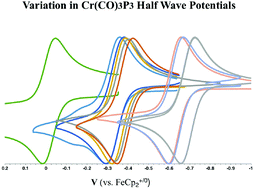Inductive modulation of tris(phosphinomethyl)phenylborate donation at group VI metals via borate phenyl substituent modification†
Abstract
A series of zerovalent group VI metal complexes of tris(diisopropylphosphinomethyl)phenylborate ([PhB(CH2PiPr2)3]−, PhBPiPr3), including [PPN][M(CO)3(PhBPiPr3)] (M = Cr, Mo, W) and the first bimetallics in which PhBPiPr3 serves as a bridging ligand via binding M(CO)3 units at the three phosphorus atoms and the borate phenyl substituent, have been synthesized and fully characterized. Two new tris(phosphinomethyl)borates featuring 3,5-dimethylphenyl and 3,5-bis(trifluoromethyl)phenyl borate substituents were prepared as crystallographically characterized thallium salts, and metallated giving their inaugural transition metal complexes [PPN][M(CO)3(((3,5-Me)C6H3)BPPh3)] and [PPN][M(CO)3(((3,5-CF3)C6H3)BPPh3)]. A comparative ν(CO) infrared spectroscopic analysis and examination of half wave potentials assessed by cyclic voltammetry supports a ligand donor ranking of Tp > PhBPiPr3 ≥ Cp > PhBPPh3 > triphos. For these anionic complexes, in which a lower electrostatic contribution to zerovalent metal-PhBPR3 binding is likely operative relative to that present in the zwitterionic complexes most commonly prepared with tris(phosphinomethyl)borates, PhBPR3 ligands do not function as strongly donating scorpionates. Nevertheless, PhBPPh3 is a substantially stronger donor than triphos towards zerovalent M(CO)3; the half wave potentials of [Et4N][M(CO)3(PhBPPh3)] are ∼340 mV lower than those of M(CO)3(triphos). The potentials of the ((3,5-Me)C6H3)BPPh3 group VI metal tricarbonyl anions are more negative than those of the corresponding ((3,5-CF3)C6H3)BPPh3 group VI metal tricarbonyl anions by ∼50 mV, suggesting a modest, yet rational, tuning of PhBPPh3 donation via inductive modulation of the borate anion charge.



 Please wait while we load your content...
Please wait while we load your content...
